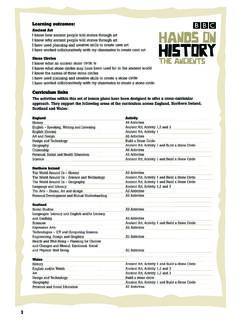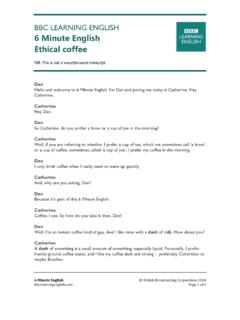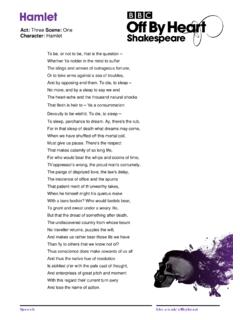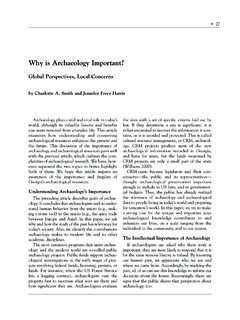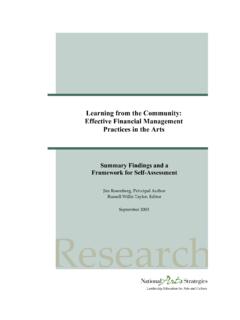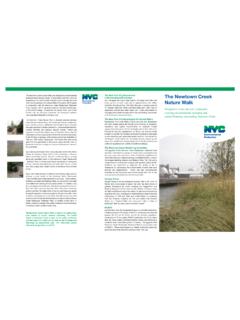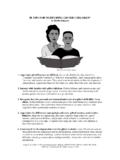Transcription of Lesson Plan: Waterlilies by Monet - BBC
1 Aims and Objectives 1. To consider the background of the Industrial Revolution and its influence on the ordinary lives of the people of Wales during the nineteenth century. 2. To consider how the prosperity of one person during the Industrial Revolution (David Davies of Llandinam) continues to have an impact on Wales To consider the Davies sisters valuable contribution to cultural life and the arts in Wales during the twentieth To learn about the Impressionism art movement and its origins in France at the end of the nineteenth To develop chronological To develop information processing skills: questioning, reasoning, creative evaluation, information gathering, thinking and HistoryLesson plan : Waterlilies by MonetPrimary History.
2 BBC 2011 Resources Interactive white board (IWB) Classroom computers/computer room A picture and descriptions of the Waterlilies by Claude Monet Small timeline cards for David Davies of Llandinam Two pictures of a town in Wales during the nineteenth century to display on the IWB A picture of David Davies to display on the IWB A picture of Barry Port to display on the IWB Examples of paintings by Impressionist artists A resource showing satellite images of Earth Information books and the internet Interactive quizWorksheets: source analysis Impressionist artistsActivities: The Davies sisters background David Davies of Llandinam cardsTeaching and learning activitiesIntroduction1.
3 Display the picture of Monet s Waterlilies on the IWB. Encourage the pupils to discuss the painting briefly, before asking them who they think was responsible for painting it and where in the world do they think it is exhibited today. Discuss their answers, before informing them that this version of Monet s Waterlilies can be seen at the National Museum in Cardiff. Did they expect this? Why could this be surprising?British HistoryLesson plan : Waterlilies by MonetPrimary History: BBC 20112. Explain to the pupils that they will learn today how Monet s Waterlilies came to be exhibited at the National Museum in Cardiff.
4 Display a picture of David Davies of Llandinam on the IWB, and explain that the story begins with this Discuss the background to the Industrial Revolution in Wales, and refer to the major changes that impacted on the Welsh economy and society by the middle of the nineteenth century. Explain that it stemmed from the huge development in the iron, coal, cotton, textile, wool, slate and lead industries, and that factories, railways, canals and ports developed as a result. State that Wales was the second largest industrial country in the world after England in 1851, and that the population of England and Wales had increased from million in 1801 to million in 1881.
5 Explain how south Wales in particular changed from an agricultural area at the beginning of the nineteenth century to a primarily industrial area by the end of that century. (A photograph of a Welsh town affected by the Industrial Revolution such as Rhondda or Blaenau Ffestiniog could be displayed on the IWB to ensure pupils understanding of the extent of the development that occurred in many areas of Wales during this period).4. Display a picture of Barry Port on the IWB. Explain that Barry Port was built in 1889 to meet a huge need to export coal from South Wales to all four corners of the world. (The ports of Cardiff and Penarth were already extremely busy).
6 By 1913, primarily because of its location and the railway line, Barry Port became one of the largest coal export ports in the world. It cost 2 million to build, and the population of Barry increased from fewer than 100 in 1881 to almost 13,000 by Tell the class that David Davies of Llandinam was one of the most prominent figures of the Industrial Revolution in Wales and that he had a strong link to Barry Port. Refer to the fact that the wealth gained by David Davies and his family as a result of the Industrial Revolution continues to influence Wales in an unexpected way to this Divide the class into groups of three or four and distribute the David Davies of Llandinam cards showing some of the main events in David Davies life.
7 Ask the pupils in their groups to put the cards in the correct chronological Display a picture of Monet s Waterlilies on the Divide the class into groups of three or four and ask them to complete the source analysis worksheet after reading the information about the object on the website. Groups could work on individual computers in the ITC room or in the After completing the activity, encourage the pupils to share the information they have found about Monet s Waterlilies with the rest of the Discuss the Davies sisters art collection as a class. Is it surprising that the works of some of the world s best artists were owned at one time by two sisters from mid Wales?
8 What does this tell us about the success and wealth of their grandfather, David Davies of Llandinam, British HistoryLesson plan : Waterlilies by MonetPrimary History: BBC 2011during the Industrial Revolution? What influence did their generous gift to the National Museum of Wales have on Wales national art collection? Two1. Read through the Davies sisters background worksheet on the IWB with the class, emphasising the link between Margaret and Gwendoline Davies and Monet s Waterlilies Divide pupils into groups of three or four, and ask them to complete the activity based on the background of the Davies Discuss each group s answers, asking members of each group to note which facts they found the most interesting about the Davies sisters, and Discuss the fact that the Davies sisters were considered to be connoisseurs with exquisite taste in the arts.
9 And that they were extremely influential women during and after their own era. Ask the pupils to give examples of what made them so interesting, unique and important in the context of the arts in Emphasise the fact that it is due to David Davies wealth as a result of the Industrial Revolution in Wales, through his granddaughters, that Wales now boasts a unique and impressive art Discuss works of art from the Impressionism movement with the class. Explain that the first Impressionists were a group of young artists who lived and worked mainly in Paris during the 1870s and 1880s. They were fed up with the old-fashioned traditional style of art, and wanted to use more experimental styles in their work.
10 The name of the movement came from a title of a picture by Monet , Impression, Sunrise (Impression, Soleil Levant). In 1874 they staged their first independent exhibition, which included works by Claude Monet , Camille Pissarro, Edgar Degas, Auguste Renoir, Alfred Sisley and Paul C Discuss briefly some of the most prominent characteristics of the Impressionists. (Examples of the work of Impressionist artists could be displayed on the IWB or shared among the groups during the discussion.) Before that, pictures of still life, portraits and landscapes were usually painted in a studio, but the Impressionists took their work to the open air to convey the reality of the modern world.

